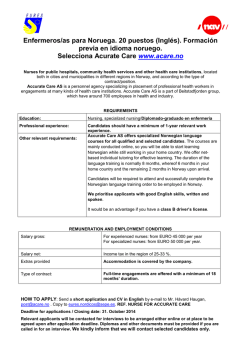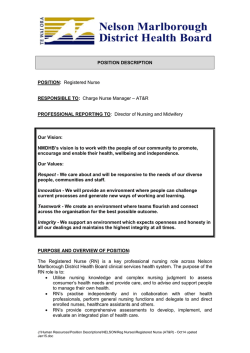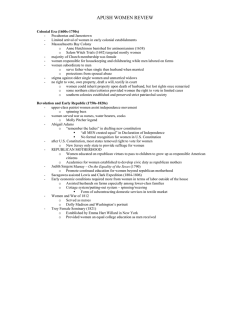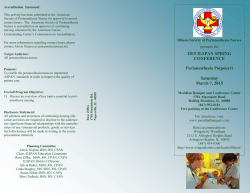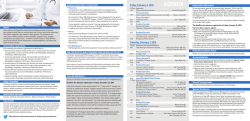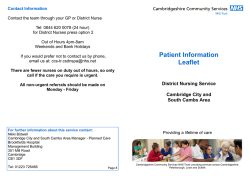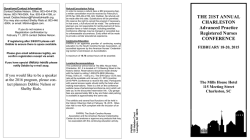
Full Text: PDF
Pinnacle Medicine & Medical Sciences ISSN: 2360-9516 http:/www.pjpub.org © Author(s) 2015. CC Attribution 3.0 License. Research Article Vol. 2 (2), 2015 Attitude Of Nurse To Expectant Mother's In Issste Hospital, Chilpancingo Guerrero, México Sepúlveda Covarrubias Maribel¹*, Jarquı́n Sepúlveda Areli² & Sánchez Castillo Martha Leticia y Dı́az González Lucio³ ¹Unidad Académica de Enfermerı́a No. 1 ²Instituto Windsor ³Unidad Académica de Matemáticas Accepted 11 February 2015 ABSTRACT Introduction: Child birth is always associated with a risk or danger, which varies in different societies is the notion of danger, for some it is a threat to the life of the mother and/or child, for others it is a threat of supe natural character. The attitude, expression or tone of voice in which the nurse's communicates with patient during the first contact may influence their feelings at the time of birth. Objective: To identify the attitude of nurses to pain in patients in labor at the hospital Issste of Chilpancingo, Guerrero. Method: a quantitative, cross -sectional descriptive study was conducted in 50 nurses and 50 patients beneficiaries of the delivery room, the information was obtained directly through the patients and nurses, the technique used was the interview in which the attitude of the nurse through the questionnaire and observation guide was assessed. Results: More than half of the nurses have a favorable attitude toward patients with pain of childbirth, the most nurses accomplish with having a kindness attitude with the patients as instructed in the NANDA (Nor American Nursing Diagnosis Association), that shows more than half of the nurses always attends the call at the moment the patient has contractions; correctly applying the rules of the hospital indicating that all patients are entitled to receive verbal information either directly or indirectly, teach basic types of breathing, emotional support, and enter in advance the delivery room., but more than half of the nurses do not perform therapeutic measures such as friction, tapping, back massage to ease the pain of childbirth, knowing that these techniques are required to keep expectant mother's calm and relaxed for a moment, they do not record the duration of contractions and do not perform leopold maneuvers to verify the position of the baby. Discussion: The majority of nurses participate actively making appropriate at each stage of labor procedures showing a positive attitude that meets the needs of the patient and build self-esteem by 84%, and support for the most convenient breathing techniques at each stage of labor as this helps oxygenation product. but 74% of nurses do not perform therapeutic measures such as friction, tapping, back massage to ease the pain of childbirth techniques required to keep expectant mothers calm and relaxed for a moment, 82 % does not record the duration of contractions and 90% do not perform maneuvers leopold to verify the position of the baby. Conclusion: According to the data obtained by the observation guide, over half of the nurses in Issste Hospital have a favorable attitude in the care they give patients this coincides with the results of the questionnaire applied to users and therefore entitled nurses if they comply with attitude really necessary to provide quality health care services to expected mother's. Keywords: Attitude, Pain, Childbirth, expectant mother's, labor. Introduction Childbirth is an initiation for women, since becoming a mother, is a function that society considers as "the most important value " for women. From a physiological point of view, each woman experiences the same process, anywhere in the world, both in the field and in the city, in the first or third world. The biology of birth is the same at the end of pregnancy, the matrix begins to have contractions and the baby out with slight variations depending on the time of pregnancy, the birth of the fetus and the status of women. Childbirth is considered a biopsychosocial and cultural event, is structured by the society in which it is performed, child birth everywhere is considered an important event in the life cycle: transforms women to mother's and in many societies, the woman is not considered as such until she gives birth to a child. Child delivery is always associated with a risk or danger, which varies in different societies, for some it is a Corresponding Author: Sepúlveda Covarrubias Maribel¹* Unidad Académica de Enfermerı́a No. 1. Email: [email protected] threat to the life of the mother and/or child, for others it is a threat of supernatural character. Each cultural system has created and established practices consistent with an overview of the world of the supernatural, the way we live and decide on the body, roles and responsibility of women. Childbirth reflects and reinforces the values that people think globally, which results in that when major changes occur at the social level, the native system tends to change. The attitude, expression or tone of voice in which the nurse communicates with the patient during the first contact may influence their feelings at the time of delivery, nursing measures support and facilitate the process and reduce the need for medical intervention. Nurses prefer silence and self-control as reactions to pain considering that good patients do not complain and control their pain, it is imperative that the nurse take special care to perceive nonverbal expressions of pain and take measure to alleviate it. Pinnacle Medicine & Medical Sciences ISSN: 2360-9516 The clarification of values is an important process that improves understanding and perception of the securities themselves, which is essential for the nurse to effectively treat patients. Patients expect to receive good health care, this requires meeting the needs related to the prevention and care of their physical, emotional integrity and service in which they are located, receive accurate, timely and understandable information to the patients and their families. Objectives / Purpose of the study Identify the attitude of nurses toward expectant mother's in Issste Hospital in Chilpancingo Guerrero, Mexico. Methodology Design and type of study: A quantitative, transversal, descriptive and observational study was performed on nurses and patients in the delivery room, in order to identify the attitude of nurses to patients in labor pain at the hospital Issste of Chilpancingo Guerrero. The sample was a convenience with a total of 50 patients delivery room, to which applied a questionnaire and an observation guide to 50 nurses through which the treatment they provide to patients to identify the nurses attitude to pain in patients with labor was observed, dependent variable was handled: attitude of the nurse. The information was obtained directly by patients and nurses, the technique used was the interview as an instrument, a questionnaire validated through a pilot test with 10 patients with similar characteristics, data were gathered in tables and were emptied in the SPSS version 15, were analysed by the description of quantitative variables by determining frequencies, and percentages once concentrated all the information proceeded to the tabulation of results and statistical tests were performed, were considered bioethical principles and signed a letter of informed consent where each of the participants decided to accept or refuse to participate in research. Page 2 Discussion In the guide of observation applied, over half of the Issste Hospital nurses have a favorable attitude in the care they give patients, this coincides with the results of the questionnaire applied to users and beneficiaries, and therefore nurses maintain positive attitude to provide quality health care. Most nurses actively involved making appropriate decision or measures at each stage of labor procedures showing a positive attitude that meets the needs of the patient and build self-esteem by 84 %, and support for the most convenient breathing techniques at each stage of labor as this helps oxygenation product. But 74% of nurses do not perform therapeutic measures such as friction, tapping, back massage to ease the pain of childbirth techniques required to keep expectant mother's calm and relaxed for a moment, 82 % does not record the duration of contractions and 90% do not perform maneuvers leopold to verify the position of the baby. In 2008 Montes A, Arbonés E. Coruña in Spain, conducted research on healthcare professionals to pain " To know the opinions and attitudes of hospital staff the results were that only 29.6 % of professionals declared transmitted written information, verbal 71.6 % Contrasting data for the guidance of nurses always 64% provides information. Gabriela Carrera, Nancy Xativa Reascos, Manual Nurse (2000) attitude, expression or tone of voice in which the nurse communicates with the patient during the first contact may influence their feelings at the time of delivery. If the patient or family are treated impersonally and hasty manner will be difficult for team members to provide care then remove the negative expression. Measures nursing support and facilitate the birth process and decrease the need for medical intervention. The nurse promotes physical well will tend to decrease anxiety and discomfort. Results According to data from the research conducted at the Hospital of the Issste of Chilpancingo Guerrero, 63.3 % of nurses have a favorable attitude toward patients with pain of childbirth. 84 % are gentle to the patients with pain of childbirth, 94% of nurses provide emotional support to patients in labor. According to the rules of the hospital, nurses indications are properly fulfilled by 82 %, to prepare the patient for the period of labor, always verifying signs and symptoms, and 78% monitors vital signs when they present the contractions. 78% assessed the intensity of pain in labor using psychological and emotional aspects such as: smile, grimace of pain, anxiety and crying. But 82 % do not take control of contractions to determine their frequency and intensity therefore fails as indicated by the manual of obstetrics and gynecology. 90 % of nurses do not perform maneuvers leopold but actively participates in the second stage of labor. And 74 % of nurses do not perform therapeutic measures recommended to reduce pain. In contrast to the results obtained by the observation guide for health personnel to assess the intensity of pain in labor taking into account the emotional and psychological aspects: smile, grimace of pain, anxiety and crying the following results 78% if value. Conclusion More than half of the nurses have a favorable attitude towards patients in labor pain because it goes with kindness as indicated in the manual NANDA (Nor American Nursing Diagnosis Association), nursing actions support and facilitate the delivery process thus reducing the need for medical intervention. The nurse with a friendly attitude promotes physical, decreases anxiety and discomfort that inspires confidence in the mother. According to the rules of hospital Issste half of nurses duly fulfills the signs to prepare the patient for the period of labor How to Cite this Article: Sepúlveda Covarrubias Maribel, Jarquı́n Sepúlveda Areli & Sánchez Castillo Martha Leticia y Dı́az González Lucio "Attitude Of Nurse To Expectant Mother's In Issste Hospital, Chilpancingo Guerrero, México" Pinnacle Medicine & Medical Sciences ISSN: 2360‐9516, Vol. 2 (2), 2015, Article ID pmms_176, 510-512, 2015. Pinnacle Medicine & Medical Sciences ISSN: 2360-9516 Page 3 always verifying signs and symptoms, describes to the patient the process of labor, provides information on coping with pain, encouraged to express their feelings in the process assesses the intensity of labor pain using psychological and emotional aspects as: smile, grin of pain, anxiety and crying, promotes self-esteem, gives emotional support and maintains her privacy. 2. Alberto Botero Uribe, Jaime Alfonso Jubitz, Guillermo Henao (2007). Obstetricia y ginecologı́a. Puebla, México Páginas; 349‐ 358. 3. Carrera Gabriela, Játiva Reascos Nancy (2002), manual de la enfermera, la actitud, expresión o tono de voz en los que la enfermera se comunica con la paciente durante el primer contacto. The nurses come into contact with people from varied cultural backgrounds, so it is crucial to understand the differences to treat pain effectively, often project their values in patients of different cultures and beliefs, it is possible that the nurse refuses to observe the following pain and allow the patient to the mercy of the pain. 4. Moorhead Sue, Maas Meridean y Johnson Marion (2005). Clasificación de los resultados de Enfermerı́a (NOC). Tercera edición, Madrid, España. Editorial: Elsevier. 5. McCloskey Dochterman Joanne y Bulecheck Gloria M (2005). Clasificación de Intervenciones de Enfermerı́a (NIC). Cuarta edición, Madrid, España, Editorial: Elsevier. Some nurses prefer silence and self-control as reactions to pain considering that good patients do not complain and control their pain is imperative that the nurse take special care to perceive nonverbal expressions of pain and take measure to alleviate it. 6. Stoppard Miriam (2006), House Mondadori Randon concepción, embarazo y parto. The clarification of values is an important process that improves understanding and perception and are essential for the nurse to effectively treat and support patients with pain of childbirth. But more than half of nurses do not perform therapeutic measures such as friction, tapping, back massage to ease the pain of childbirth, knowing that these techniques are required to keep expectant mothers calm and relaxed for a moment, they do not record the duration of the contractions and no leopold maneuvers performed to verify the position of the baby. Recommendations for further studies 1. The nurses should perform maneuvers leopold to verify the position of the baby in addition to therapeutic measures such as friction, tapping, back massage to ease the pain of childbirth as they are techniques required to keep expectant mother's calm and relaxed for a time being and record the duration of contractions. 2. Implement changes in staff training, in the same way it is necessary that measures be incorporated into the health institutions to change the attitudes of these profesional health workers and work practices in favor of providing continuous support to women (from the early pregnancy until the end of this). 3. A good attention not only mean smile to the patient, but makes her smile, because in the physical state in which she is in, need emotional support, care necessary for their speedy recovery, nurses should understand and meet their welfare needs. Further research is suggested on this topic in different hospitals, but from the perspective of the doctor. References 1. Norma Oficial Mexicana NOM‐007SSA‐1993, atención de la mujer durante el embarazo, parto y puerperio y del Recién Nacido. (PDF), 6 de Enero de 1999. How to Cite this Article: Sepúlveda Covarrubias Maribel, Jarquı́n Sepúlveda Areli & Sánchez Castillo Martha Leticia y Dı́az González Lucio "Attitude Of Nurse To Expectant Mother's In Issste Hospital, Chilpancingo Guerrero, México" Pinnacle Medicine & Medical Sciences ISSN: 2360‐9516, Vol. 2 (2), 2015, Article ID pmms_176, 510-512, 2015.
© Copyright 2025
